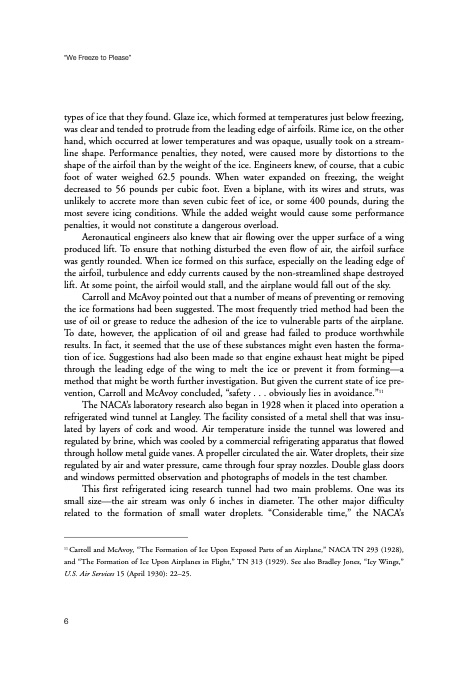
PDF Publication Title:
Text from PDF Page: 019
“We Freeze to Please” types of ice that they found. Glaze ice, which formed at temperatures just below freezing, was clear and tended to protrude from the leading edge of airfoils. Rime ice, on the other hand, which occurred at lower temperatures and was opaque, usually took on a stream- line shape. Performance penalties, they noted, were caused more by distortions to the shape of the airfoil than by the weight of the ice. Engineers knew, of course, that a cubic foot of water weighed 62.5 pounds. When water expanded on freezing, the weight decreased to 56 pounds per cubic foot. Even a biplane, with its wires and struts, was unlikely to accrete more than seven cubic feet of ice, or some 400 pounds, during the most severe icing conditions. While the added weight would cause some performance penalties, it would not constitute a dangerous overload. Aeronautical engineers also knew that air flowing over the upper surface of a wing produced lift. To ensure that nothing disturbed the even flow of air, the airfoil surface was gently rounded. When ice formed on this surface, especially on the leading edge of the airfoil, turbulence and eddy currents caused by the non-streamlined shape destroyed lift. At some point, the airfoil would stall, and the airplane would fall out of the sky. Carroll and McAvoy pointed out that a number of means of preventing or removing the ice formations had been suggested. The most frequently tried method had been the use of oil or grease to reduce the adhesion of the ice to vulnerable parts of the airplane. To date, however, the application of oil and grease had failed to produce worthwhile results. In fact, it seemed that the use of these substances might even hasten the forma- tion of ice. Suggestions had also been made so that engine exhaust heat might be piped through the leading edge of the wing to melt the ice or prevent it from forming—a method that might be worth further investigation. But given the current state of ice pre- vention, Carroll and McAvoy concluded, “safety . . . obviously lies in avoidance.”11 The NACA’s laboratory research also began in 1928 when it placed into operation a refrigerated wind tunnel at Langley. The facility consisted of a metal shell that was insu- lated by layers of cork and wood. Air temperature inside the tunnel was lowered and regulated by brine, which was cooled by a commercial refrigerating apparatus that flowed through hollow metal guide vanes. A propeller circulated the air. Water droplets, their size regulated by air and water pressure, came through four spray nozzles. Double glass doors and windows permitted observation and photographs of models in the test chamber. This first refrigerated icing research tunnel had two main problems. One was its small size—the air stream was only 6 inches in diameter. The other major difficulty related to the formation of small water droplets. “Considerable time,” the NACA’s 11 Carroll and McAvoy, “The Formation of Ice Upon Exposed Parts of an Airplane,” NACA TN 293 (1928), and “The Formation of Ice Upon Airplanes in Flight,” TN 313 (1929). See also Bradley Jones, “Icy Wings,” U.S. Air Services 15 (April 1930): 22–25. 6PDF Image | History of NASA Icing Research Tunnel

PDF Search Title:
History of NASA Icing Research TunnelOriginal File Name Searched:
sp4226.pdfDIY PDF Search: Google It | Yahoo | Bing
NFT (Non Fungible Token): Buy our tech, design, development or system NFT and become part of our tech NFT network... More Info
IT XR Project Redstone NFT Available for Sale: NFT for high tech turbine design with one part 3D printed counter-rotating energy turbine. Be part of the future with this NFT. Can be bought and sold but only one design NFT exists. Royalties go to the developer (Infinity) to keep enhancing design and applications... More Info
Infinity Turbine IT XR Project Redstone Design: NFT for sale... NFT for high tech turbine design with one part 3D printed counter-rotating energy turbine. Includes all rights to this turbine design, including license for Fluid Handling Block I and II for the turbine assembly and housing. The NFT includes the blueprints (cad/cam), revenue streams, and all future development of the IT XR Project Redstone... More Info
Infinity Turbine ROT Radial Outflow Turbine 24 Design and Worldwide Rights: NFT for sale... NFT for the ROT 24 energy turbine. Be part of the future with this NFT. This design can be bought and sold but only one design NFT exists. You may manufacture the unit, or get the revenues from its sale from Infinity Turbine. Royalties go to the developer (Infinity) to keep enhancing design and applications... More Info
Infinity Supercritical CO2 10 Liter Extractor Design and Worldwide Rights: The Infinity Supercritical 10L CO2 extractor is for botanical oil extraction, which is rich in terpenes and can produce shelf ready full spectrum oil. With over 5 years of development, this industry leader mature extractor machine has been sold since 2015 and is part of many profitable businesses. The process can also be used for electrowinning, e-waste recycling, and lithium battery recycling, gold mining electronic wastes, precious metals. CO2 can also be used in a reverse fuel cell with nafion to make a gas-to-liquids fuel, such as methanol, ethanol and butanol or ethylene. Supercritical CO2 has also been used for treating nafion to make it more effective catalyst. This NFT is for the purchase of worldwide rights which includes the design. More Info
NFT (Non Fungible Token): Buy our tech, design, development or system NFT and become part of our tech NFT network... More Info
Infinity Turbine Products: Special for this month, any plans are $10,000 for complete Cad/Cam blueprints. License is for one build. Try before you buy a production license. May pay by Bitcoin or other Crypto. Products Page... More Info
| CONTACT TEL: 608-238-6001 Email: greg@infinityturbine.com | RSS | AMP |